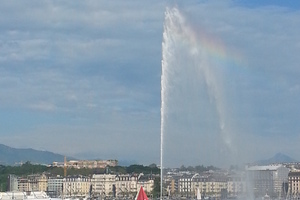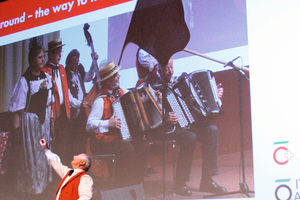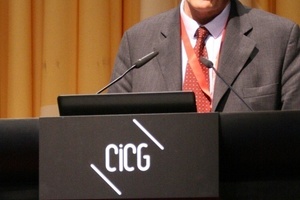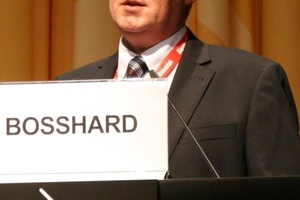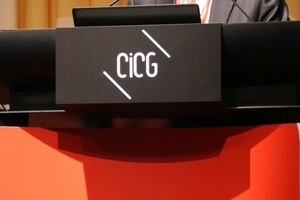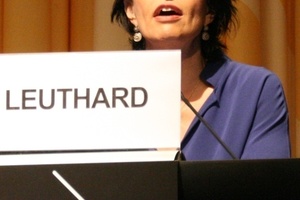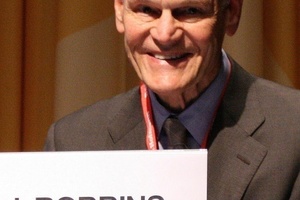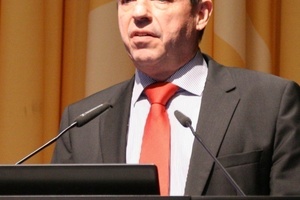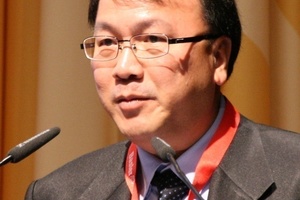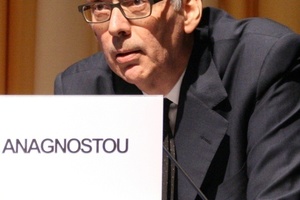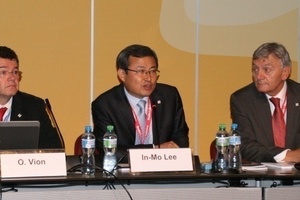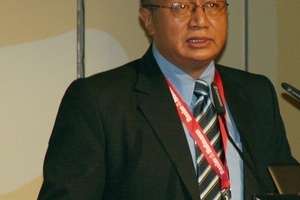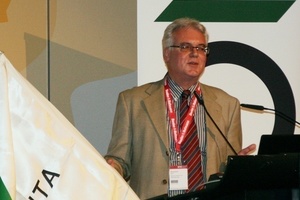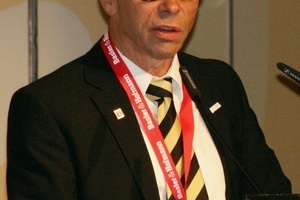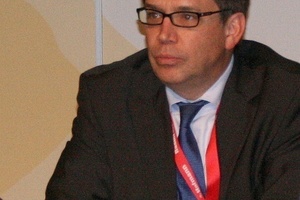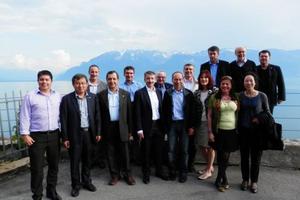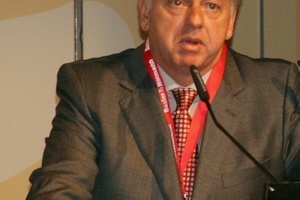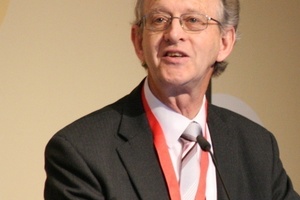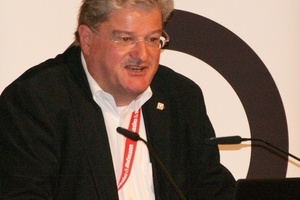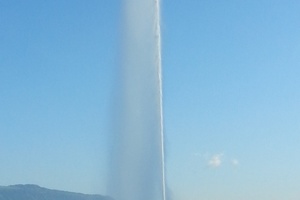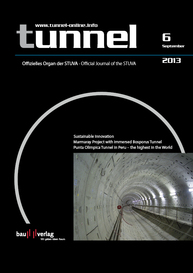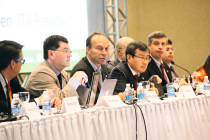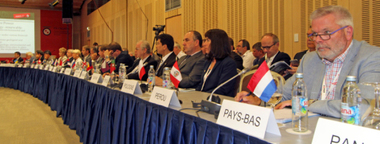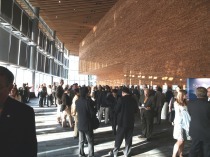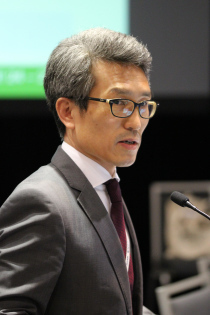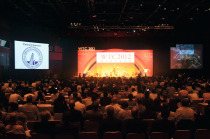39th Annual Meeting of the ITA – World Tunnel Congress WTC 2013 in Geneva, Switzerland
Every year tunnellers meet in a different member country somewhere in the world for their ITA annual meeting and discuss the latest trends and developments. The following report provides an overview of the contents of the WTC 2013, the results of the Working Groups (WGs) and further news.
1 General
More than 1,800 tunnellers from 58 countries got together in Geneva, Switzerland from May 31 to June 5, 2013. The occasion was the 39th General Assembly of the ITA – International Tunnelling and Underground Space Association – in conjunction with the 2013 World Tunnel Congress. The WTC 2013 was organised by the Swiss Tunnelling Society and was captioned “Underground – the Way to the Future” (Fig. 1). 58 of the 71 ITA member countries were present in Geneva. With 82 % the share of countries represented reached a similar level to last year (approx. 78 %).
The following countries were represented: Argentina, Australia, Austria, Azerbaijan, Belarus, Belgium, Bhutan, Bosnia and Herzegovina, Brazil, Bulgaria, Canada, Chile, China, Colombia, Costa-Rica, Croatia, Czech Republic, Denmark, Ecuador, Egypt, Finland, France, Germany, Greece, Hungary, Iceland, India, Indonesia, Iran, Italy, Japan, Macedonia (FYROM), Malaysia, Mexico, Montenegro, Nepal, Norway, Panama, The Netherlands, Poland, Portugal, Republic of Korea, Romania, Russia, South Africa, Spain, United Arab Emirates, United Kingdom, United States of America, Serbia, Singapore, Slovakia, Slovenia, Sweden, Switzerland, Thailand, Turkey, Ukraine.
The following ITA member countries did not show up in Geneva: Algeria, Saudi Arabia, Bolivia, Cambodia, Israel, Kazakhstan, Lao PDR, Lesotho, Morocco, Myanmar, Peru, Venezuela, Vietnam.
2 WTC 2013
The World Tunnel Congress was largely prepared and organised by the Swiss Tunnelling Society in close collaboration with the ITA. The conference programme embraced 10 groups of topics, presented at 24 technical sessions:
1. Underground space utilization, tunnel refurbishment.
2. Construction technology developments (Developments in the technology of mechanized tunnelling, TBM performance and wear).
3. Tunnel operation (Safety and other operational issues).
4. Construction technology developments (Developments in the technology of mechanized tunnelling and monitoring).
5. Case histories (Underground constructions for hydropower and other hydraulic tunnels).
6. Case histories (AlpTransit tunnels and tunnels in particularly demanding geological conditions).
7. Project planning and implementation.
8. Design and analysis methods and considerations.
9. Case histories.
10. Construction technology developments.
The papers presented at the sessions were backed up by poster presentations and an accompanying exhibition.
ITA Training Course
As in previous years, a special ITA Training Course took place prior to the Congress on May 31 and June 1, 2013. This time it was staged jointly by the Swiss Tunnelling Society (STS), the ITA and the ITACET Foundation. The course aimed at young professionals bore the title “Ground Improvement, Pre-Support and Reinforcement”. Altogether 130 participants from 30 different nations – including 20 students from Geneva, Zurich and Lausanne – took advantage of the opportunity to learn more about underground construction.
The 16 presentations from 19 internationally recognised experts from academic and entrepreneurial fields were geared to providing details on the state of the art when applying ancillary measures such as injections, jet grouting, ground freezing, pipe umbrellas/lances or face anchoring methods. The course took into account both theoretical as well as practical aspects of ancillary measures in tunnelling. Interesting case examples from all over the world catered for a lively discussion and reflected the great interest shown by the participants in the topics.
The ITACET Foundation and the Brazilian Tunnelling Committee are engaged in working out the next Training Course, which will take place at the 2014 WTC in Brazil captioned “Tunnels for Energy”.
Opening
At the opening event on the Monday (Fig. 2) Felix Amberg (chairman of the Organising Committee, Fig. 3), Martin Bosshard STS president, Fig. 4) and In-Mo Lee (ITA president, Fig. 5) first of all welcomed their audience. Then Doris Leuthard, Swiss federal minister of environment, transport, energy and communication delivered her opening address, in which she focused on the outstanding tunnelling activities accomplished in Switzerland, describing tunnellers as the “last greater adventurers” (Fig. 6).
Subsequently it was time at this year’s WTC for the fourth lectures in memory of Sir Alan Muir-Wood. In this “Muir-Wood Lecture” Dick Robbins, the former chairman of the board of Robbins (Fig. 7) dealt with “A Tradition of Innovation: The next Push for Machine Tunnelling”. Robbins examined the development of mechanised tunnelling from the early phase, which he himself accompanied with his company, up to the present. In the interim, the many innovative steps have led to modern high-tec machines, which may reduce but do not entirely preclude the risk in tunnelling. In his vision for the future he warned that the knowledge lodged in the heads of the older generation essentially had to be transferred to young up-and-comers. Robbins is convinced that there are plenty of opportunities for further developments.
Then, 3 high quality keynote papers were presented:
1. Challenges of Swiss motorway tunnels in the past and the future (Dr. Rudolf Dieterle, Director of Federal Roads Office (FEDRO), Switzerland).
2. Creation and Utilization of Underground Space in Singapore: Developments and Future Challenges (Chong Kheng Chua, Vice Director LTA, Singapore).
3. Underground Construction in Switzerland (Prof. Dr. Georg Anagnostou, ETH Zurich, Switzerland).
Dieterle (Fig. 8) highlighted the special importance of tunnelling for Switzerland in his lecture. As a result of its topography, Switzerland possesses the highest proportion of bridge and tunnel km in relation to the total highway network. Particularly against the background that Switzerland is a transit country, furthermore the infrastructure has a considerable load to bear. Dieterle explained how technical standards have developed in the course of time and which demands are posed on tunnels nowadays. He particularly drew attention to safety aspects.
Chua (Fig. 9) first of all displayed how Singapore on account of its small area is forced to exploit underground space in particular. To ensure that this occurs as efficiently as possible, Singapore has drawn up an underground space utilization plan with its “Underground Masterplan”. As a result, underground space at a depth of 5 to 10 m is reserved for basements for houses and service tunnels. Metro and road tunnels are located at a depth of up to 40 m and sewage systems and energy tunnels even deeper ranging down to 60 m. Rock caverns are to be found at an even greater depth (at more than 100 m). He provided examples of the resultant challenges.
Anagnostou (Fig. 10) provided an overview of the historical development of tunnelling in Switzerland, which began with the construction of rail tunnels and tunnels for hydro power stations. In this connection he made an assertion on conventional tunnelling, which resulted in a lively discussion during the course of the WTC: “I feel obliged to make clear that the NATM had never anything to do with tunnelling in Switzerland.” In this connection, he referred to an (alleged) remark contained in the book “50 Years NATM” published by the ITA Austria in 2012, according to which the New Austrian Tunnelling Method (NATM) was also applied for producing the new Gotthard rail tunnel.
It should be observed in this connection that Anagnostou was chosen by the ITA board, to present the next Muir-Wood lecture at the 2014 WTC in Brazil.
Open Session
At the start of the ITA Open Session on the Tuesday the results of the Working Groups were presented to a larger audience. In summing up it can be said that a total of 4 new ITA reports were published in the past year: 2 by the ITA Working Groups and 2 by the ITA-TECH Committee.
Working Group 17 (Long Tunnels at great Depth) published a report on “Adits for long and Deep Tunnels” and Working Group 19 (Conventional Tunnelling) published “Guidelines on Contractual Aspects of Conventional Tunnelling”.
The ITA-TECH Working Groups firstly issued “Guidelines on Standard Indication of Load Cases for Calculation of Rating Life (L10) of TBM Main Bearings”. In addition they presented a “Design Guidance for Spray Applied Waterproofing Membranes”.
The following part of the Open Session this year was devoted to the topic “Deciding on Better and Resilient Cities”. The Open Session was an element of the so-called “ITA Global Perspective”, captioned “Urban Underground Space in a Changing World”.
Over a period of 3 years the ITA examined how underground space can contribute towards solving 2 urgent problems faced by the world: this is on the one hand the topic of “Urbanisation” as pursued by the United Nations Human Settlements Programme (UN-HABITAT), and secondly “Urban Resilience to natural Catastrophes and Effects of Climate Change”, which was passed by the United Nations International Strategy for Disaster Reduction, UN-ISDR. In this respect, it was a target to collaborate with 3 global partner organisations, comprising urban planners, city administrations and engineers (ISOCARP. ICLEI and IFME), to work out media for political decision-makers, which indicate the advantages of underground facilities.
Back in 2011 in Helsinki, the ITA presented a partial aspect at an Open Session, namely “Delivering better and resilient Cities”. In 2012 in Bangkok, attention focused on “Planning better and resilient Cities”. Altogether the “ITA Global Perspective” comprises 7 activities:
1. Organising the 3 above mentioned Open Sessions by ITACUS: each of the sessions is accompanied by one of the above mentioned organisations (2011 in Helsinki: IFME; 2012 in Bangkok: ISOCARP; 2013 in Geneva: ICLEI).
2. Active inclusion of Working Groups and member states.
3. Continuous cooperation with global partners (MoU) as well as the extensive spreading of knowledge by means of congresses and workshops.
4. Working out media for political decision-makers, which illuminate the advantages of underground facilities; these are to be presented to UN-HABITAT and UN-ISDR.
5. Granting allowances to students (in conjunction with ITACET) in order to attain further results, such as how underground spaces can contribute to the above mentioned global topics.
6. Further development of the ITA Global Perspective in the form of an initiative, towards which end companies operating on an international basis can commit themselves.
7. Carrying out annual or semi-annual summit meetings with decision-makers from cities in order to further develop the ITA Global Perspective so that it can become established as an element of the commitment shared with the 2 UN organisations.
Many of the above mentioned aims have already been achieved: the special sessions were successfully staged (1.), collaboration with the ITA Working Groups started (2.), the agreements with the partner institutions ISOCARP, ICLEI and IFME have been signed and interest has been aroused at UN-ISDR and UN-HABITAT (3.), a video has been produced for political decision-makers (4.) and training courses have been evolved and executed together with ITACET (5.). The further development of the ITA Global Perspective and the holding of summit meetings represent an on-going topic (6., 7.).
Within the ITA, ITACUS, the Committee of Underground Space, coordinates and stages the activities relating to the Global Perspective. When it was initiated, the Committee set about propagating public awareness of the opportunities afforded by underground space and facilities.
The special session within the scope of the WTC ’13 was thus opened and chaired by Han Admiraal, the chairman of ITACUS and Antonia Cornaro, the ITACUS secretary-general. Firstly, Margaretta Wahlström, UN special representative for disaster reduction, UN-ISDR, Office for Disaster Reduction, reported on “Decision-Making – Global Perspective Insight” in an initial block devoted to decision-making relating to the “UN-ISDN Resilient City Campaign”. Subsequently David Cadman, ICLEI president and the former deputy mayor of Vancouver, posed the question “Are we asking too much of decision-makers?” Finally, Samuel K. C. Ng, who heads the geotechnical department of the Hong Kong Foundation Engineering Office, asked “Why is Hong Kong investing in large-scale underground development and what is their strategy?”
During the session’s second block the issue related to what can be done to influence decision-makers: “What you can do – Global Perspective Action”. Towards this end, firstly Yvette Körber, managing partner of the Cargo Tube AG, put forward the notion of establishing an underground system for transporting goods in Switzerland “Moving cargo underground using a dedicated system: Cargo sous terrain”. Then James Ramsey, an architect with the RAAD Studios in New York, presented the “Lowline Project” displaying how an abandoned subway station in Manhattan is being converted into a park: “How we are making and shaping the Lowline”.
Apart from Wahlström, Cadman and Ramsey, Jean-Michael Paumler, Economical, Social and Environmental Council of the Greater Paris Region, and Shipra Narange Suri, vice-president of ISOCARP, also took part in the podium discussion chaired by Admiraal and Cornaro. Together they considered a roadmap regarding how in future the many aspects for the efficient use of underground space in mega cities can be communicated and what the individual organisations can contribute towards this.
It is also worth mentioning that ITACUS has produced 2 new videos since the last WTC, which explain the advantages of using underground space: “Imagine your City” and “Why not?”. Both videos are available via the ITA web page.
Swiss special Features
The STS enriched this year’s WTC with a number of special features, which were novel for ITA congresses. For example, the Swiss Tunnel Congress, normally held in Lucerne in May each year, was integrated in the WTC as the “Swiss Session”. This included the colloquium on the Tuesday, which resembled a training course, as well as the series of lectures on the Wednesday. Parallel to this there was a further series of papers presented on the Wednesday afternoon by young Swiss engineers, the “Young Swiss Tunnellers”.
In addition on the Friday prior to the WTC, a “deminar” was held – a cross between a demonstration and seminar – under the aegis of ITA-TECH on sprayable seals: “Sprayable Waterproofing Membranes”. 58 participants turned up for this. Furthermore the ITA-TECH staged an “Innovative Session” on the Tuesday at the WTC, at which the activities and goals of this organisation were presented. At a further “Presentation Session”, staged in conjunction with the exhibition, exhibitors and other interested parties were able to present new products or projects.
On account of the other elements taking place parallel to the technical papers – such as the ITA General Assembly, various Working Group sessions, poster presentations, the ITA-COSUP Workshop – many visitors to the Congress complained that they had not been able to attend all the events that had caught their interest.
3 General Assembly
President In-Mo Lee, Korea (Fig. 11) chaired the General Assembly. To start with Lee informed the delegates about how membership had developed. The number of member countries increased by 3 compared with the previous year to reach 71. Bhutan, Bolivia and Cambodia are the new members (Fig. 12). In addition, there are a further 25 corporative and 5 individual new members. Taking outgoing members into account, the ITA can now lay claim to 71 member nations, 199 corporative and 103 individual members. One company has ceased its activities as a “prime sponsor”. On the other hand, 25 new “supporters” were gained. As a result, the ITA has now a total of 14 prime sponsors and 51 supporters.
At the General Assembly in Bangkok, Australia proposed a change in the selection criteria for determining the venue for the WTC and the General Assembly. The background to this is the fact that certain commitments at the application stage (e. g. venue and dates) are then not adhered to when things actually take place. The Executive Council thus proposed a change in the application terms to the General Assembly, which the General Assembly duly accepted. The following aspects were approved:
In future it must be determined to what extent the venue is relevant for tunnelling in the member country and for the tunnelling industry as a whole.
The suitability of the conference centre has to be verified; in this respect, aspects such as General Assembly, exhibition, lectures, Working Groups, Committees or internet access must be considered.
The Congress topic, the date and the provisional programme must be laid down.
The participation fees must not be excessively high and should be cited at the application stage.
A sufficient amount of hotel facilities must be available and the price categories have to be cited in advance.
Corresponding experience of organising similar events and possible synergy effects must be established.
The application must be handed in by January 10 and will then be scrutinised by the Executive Council to ensure it conforms to the conditions.
Applications that conform will be presented to the member states for scrutiny.
The country applying is permitted to provide a 15-minute long presentation at the General Assembly.
It was further agreed that ballots in written form for voting at the General Assembly as well as nominating proxy representatives must arrive in the Secretariat at least 9 days prior to the Assembly. It was also suggested that against the ever growing ITA budget, financing the work of prime sponsors and supporters as well as on account of cooperation with the UNO, a paragraph on regulating the ITA should be included in the statutes. In this respect the “Compliance Manual” of the World Association of Non-Governmental Organisations (WANGO) should be referred to as far as possible.
As in previous years the General Assembly also turned its attention to the means of communication used by the ITA and how these have developed: The last time ITA News appeared in printed form as the “Tribune” was at the 2011 WTC in Finland. Last year the news was only published on the ITA web page. This year a loose-leaf collection of information pertaining to countries was also distributed at trhe General Assembly. It must be said though that readiness to report on national activities differs greatly: Although the number of member countries has risen considerably in recent years (2007 to 2012: from 52 to 71), the number of reports (with just over 30) has remained constant. Since the General Assembly in Bangkok (Thailand) in May 2012, 5 issues of the “ita@news” have been released and sent per e-mail. Altogether since the newsletter was first published, the latest news from the ITA, the Working Groups, the member countries, on future conferences relating to tunnelling, exhibitions, workshops and seminars as well as details on activities of international associated organisations has appeared 49 times. The ita@news is distributed to around 8,000 persons, companies, engineering offices and other institutions. The ITA Secretariat is keen to obtain a feedback from regular readers.
ITA members can also only access the ITA scientific organ, the journal “Tunnelling and Underground Space Technology (TUST”) in electronic form – albeit the entire archive is available. In 2012 (year 27) 6 issues appeared, which altogether comprised almost 1,300 pages. In 2013 (year 28) so far a further 5 issues have appeared with more than 800 pages.
The ITA web page is frequented by around 5,800 visitors per month from some 130 different countries. It was thoroughly revised in the run-up to the WTC and has been generally available since early June. The home page is intended for decision-makers and the general public and explains for example, how underground space can be utilised and existing construction methods. It mentions specific advantages and provides information about planning, construction and operation. The second part, the “corporate web page” provides information on the set-up of the ITA, the member countries, the corporative members, the publications, the committees and Working Groups as well as on events dealing with underground construction. In addition to the pages that are generally accessible, there is also a section protected by a password for internal exchange of data.
Furthermore the contacts maintained by the ITA to various international sister organisations and UN organisations (Table 1) were reported on. Five of them provided details of their cooperation at the General Assembly: ITIG, PIARC, ISOCARP, Un-Habitat and UN-ISDR.
As was the case in previous years, the report on the activities of the various ITA Working Groups occupied a large chunk of the General Assembly’s time. The relevant details are to be found in Chapter 5 and www.tunnel-online.info.
The General Assembly was also faced with the task of selecting the venue for the 2016 Annual Meeting. It was an easy decision as there was only one candidate: thus San Francisco (USA) was chosen. In this connection, the dates and venues for future Annual Meetings are of interest:
May 9 to 15, 2014, 40th ITA Annual Meeting in Foz do Iguaçu (Brazil); captioned “Tunnels for Better Living” (Fig. 13).
May 22 to 28, 2015, 41st ITA Annual Meeting in Dubrovnik (Croatia); with the topic: “Promoting Tunnelling in South East European Region”.
June 12 to 15, 2016, 42nd ITA Annual Meeting in San Francisco (USA); with the slogan “Uniting our Industry”; the WTC 2016 is to be held jointly with the North American Tunnelling Conference (NAT).
Under the „miscellaneous” point on the agenda, the British Tunnelling Society (BTS) proposed the setting up of an „ITA Young Members Group“ for young tunnellers. The idea is based on positive experiences, which the BTS has made with its own Young Members Group established in 2008. The new president Eskesen expressed his interest and promised that the executive council and he himself would look into the matter of how young members can be integrated in the ITA family.
4 ITA Executive Council (EC)
The 3-year period of office of president In-Mo Lee ended according to schedule with this year’s General Assembly. Two of the 4 vice-presidents were in the running to take over from him: Søren Degn Eskesen (COWI) from Denmark and Markus Thewes (Ruhr University Bochum) from Germany. Eskesen was elected as the new president for a 3-year period (Fig. 14).
In a second ballot, 4 new vice-presidents were chosen each with an absolute majority for 3 years: Tarcisio Celestino (Brazil), Amanda Elioff (USA), Rick Lovat (Canada) and Danielo Polla (Italy). Lovat received the most votes and was chosen to be the first vice-president (Fig. 15).
Initially 6 candidates put their names forward for the 6 vacant positions on the EC. However, shortly prior to the Assembly Oleksandr Okhotnikov (Ukraine) withdrew from the race. The other 5 candidates each received the necessary absolute majority and were thus elected for a 3-year period: Alexander Gomes (Chile), Ruth Gunlaug Haug (Norway), Nikolaos Kazilia (Greece), Eric Leca (France) and Jinxiu (Jenny) Yan (China).
After their tenure in office expired (2013), the following members stepped down: past-president M. Knights (UK), the other 3 vice-presidents J. Hradina (Czech Republic), M. Thewes (Germany) and B. Yun (China) as well as the EC members P. Kocsonya (Hungary) and C.N. Ow (Singapore).
The ITA Executive Council will have Davorin Kolić (Croatia) to assist it for the 2015 WTC until the event itself. The contact person for the 2014 WTC in Brazil is vice-president Celestino with vice-president Elioff fulfilling this role for the 2015 WTC.
The new ITA Executive Council lines up as follows:
S. D. Eskesen, Denmark, president until 2016.
I.-M. Lee, Korea, past-president till 2016.
R. P. Lovat, Can.ada, first vice-president until 2016.
T- Celestino, Brazil, vice-president until 2016.
A. Elioff, USA, vice-president until 2016.
D. Peila, Italy, vice-president until 2016.
A. Gomes, Chile (until 2016).
R.G. Haug, Norway (until 2016).
N. Kazilis, Greece (until 2016).
E. Leca, France (until 2016).
J. Yan, China (until 2016).
D. Kolic, Croatia (until 2015).
F. Amberg, Switzerland, treasurer (until 2016).
The General Assembly re-appointed S. Calinescu, Romania, as internal auditor for a further year. Since 2009, Olivier Vion as executive director has backed up the EC.
The responsibilities within the EC are firmly established but on account of the election of new members, there have been changes as far as the actual persons involved are concerned. The responsibilities for the previous period are indicated in brackets:
a) Technical Affairs (Thewes, Elioff and Peila).
b) General Affairs (Eskesen, Ow and Kocsonya).
c) Sponsor and Industry Relations (Hrdina and Lovat).
d) Member Nation Development and Coordination (Bai Yun):
South-East Asia (Ow and H. Wagner as external experts).
Russia and neighbouring Countries (Lovat and M. Belenkey as external experts).
e) Communication (Knights).
In addition, the following persons support the EC in special matters:
Andre Assis and Piergiorgio Grasso: Development of the Associations in South America.
Harvey Parker: Relations with the United Nations.
Eivind Grov: Relations with the Industry and ITA-TECH.
Yann Leblais: till now Working Group 11 Tutor.
Tom Melbye: representing the Prime Sponsors (2012-2014).
5 ITA Working Groups
The Working Groups contribute immensely to the positive external appearance of the ITA because collaboration among persons from various countries is accomplished here thus enabling an important exchange of views. Twelve of the active WGs met in Geneva to continue their technical discussions. In addition, a new WG 21 “Life Cycle Award Management” was established. The chairmen of the WGs briefed the General Assembly on June 5, 2013 on the stage reached by their activities and what lay ahead in the months to follow. Please find more information about the Working Groups online (www.tunnel-online.info).
Working Group 2: Research
Animateur: Chung-Sik Yoo, Korea;
vice-animateur: Elana Chirlotti, France;
tutor: Eric Leca, France.
24 experts from 16 countries were present at the consultations. As Eric Leca was elected to the ITA Executive Council, he surrendered his position as animateur to his former deputy Chung—Sik Yoo and will now function as tutor. The new vice-animateur is Elena Chirlotti.
The WG is continuing to work on a “Strategy for Site Investigations of Underground Works” in conjunction with the ISRM (International Society of Rock Mechanics). The current draft of the strategy was discussed during the session and further information and case examples included. Close cooperation is being pursued with WG 3 with regard to international standards and common procedures. The final draft of the strategy is expected in late 2013.
Furthermore, a recommendation on “Risk Management” was tackled. By and large, in this respect an ITA recommendation dating back to 2004 is to be updated and rounded off with case examples. Drafts of studies on “Steel Fibre Concrete” and “Sustainability in Tunnelling” were discussed during the session. The first recommendation is being devised in collaboration with the ITA-TECH and the International Federation for Structural Concrete. The second report is to be worked out in conjunction with WG 21 (Life Cycle Award Management).
Working Group 3: Contractual Practices in Underground Construction
Animateur: Arnold Dix, Australia;
vice-animateur: Martin Smith, UK;
tutor: Tarcisio Celestino, Brazil.
22 experts from 20 countries participated at the session. The new tutor is Tarcisio Celestino, who took over from Olivier Vion.
The WG had concentrated on various reports from other WGs in conjunction with legal issues. These dealt in particular with subjects relating to conventional tunnelling and health and safety in tunnelling. It is intended to cooperate closely with other ITA Working Groups in future as well and to support them in publishing further contractually relevant recommendations relating to their core activities.
In addition, the WG is engaged in evolving an ITA component for FIDIC contracts and is examining the contractual risks, which result from the geology and geological contract documents such as e.g. the technical report on tunnelling. Furthermore, current contracts for various projects are assessed with regard to resultant experiences.
Working Group 5: Health and Safety in Tunnelling
Animateur: Donald Lamont, UK;
vice-animateur: Martin Vogel, Switzerland;
tutor: Ruth Gunlaug Haug, Norway.
After stepping down from the EC, Ivan Hrdina is no longer the WG’s tutor. This task has been taken over by Ruth Gunlaug Haug. 22 experts from 14 countries attended the discussions. In Bangkok at the 2012 WTC, the members of this WG paid particular attention to evolving “Guidelines for the Provision of Refuge Chambers in Tunnels under Construction. Prior to this year’s WTC, a draft of the guideline was passed on to the ITA EC and selected member countries for their perusal. The feedback was discussed and a final draft collated.
In cooperation with the South African Tunnelling Committee (SANCOT) safety guidelines are being prepared for shaft construction activities. In addition, revising the guidelines for compressed air work is under consideration. Further future topics were itemised: provision for possible emergencies, safety of special vehicles for use underground as well as revision of the general guidelines on health and safety regarding detailed information on possible health dangers.
Working Group 6: Maintenance and Repair of Underground Structures
Animateur: Henry Russell, USA;
vice-animateur: René van den Bosch, Netherlands;
tutor: Bai Yun, China.
Experts from 9 countries were present at the deliberations.
Consultations in the WG concentrated on “Structural Fire Protection for Road Tunnels”, which was formerly partially included in NFPA guidelines. The original document dates back to 2004 and must be revised and expanded. The new study will feature in particular new materials, fire-fighting systems and risk analyses. Furthermore, a paper on waterproofing measures was discussed and a new document on “Maintenance of Operating Tunnels” scrutinised. This study is to be compiled in close collaboration with the newly founded WG 21.
Working Group 9: Seismic Effects
Animateur: Wenge Qiu, China;
vice-animateur: NN;
tutor: Daniele Pella, Italy.
12 experts from 5 countries attended the discussions of this WG in Geneva.
At this year’s session, further progress was made on guidelines for ensuring the safety of municipal underground structures against earthquakes, the safety of shallow tunnels, the safety of particularly long tunnels at great depth or the safety of tunnels in active fault zones. An existing draft, which in particular analyses damage that can occur, was discussed further. In addition, incoming information was analysed and a course of action agreed on.
Working Group 11: Immersed and Floating Tunnels
Animateur: Jonathan Baber, UK;
vice-animateur: Eelco van Putten, Netherlands;
tutor: Davorin Kolic, Croatia.
Jonathan Baber, the WG’s former vice-animateur has now taken over from Christian Ingerslev. The new deputy is Eelco van Putten and the tutor is Davorin Kolic (formerly Yann Leblais).
11 experts from 11 countries attended this WG’s deliberations. First of all, an overview of 10 new projects was provided, which resulted in a lively discussion on the special production technologies.
Within the framework of last year’s WTC, an “Owner’s Guide” for immersed and floating tunnels was published. It contained the first 6 sections dealing with individual aspects (concrete, cracks, fire protection, joint elements, segment joints and ventilation). A further 11 sections have been processed in the interim and were discussed within the scope of the session. 7 additional ones are being prepared. It is intended to publish a manual on environmental protection aspects of immersed and floating tunnels. Furthermore the above mentioned Owner’s Guide is to be enlarged to include a further 8 chapters. A sub-group will evolve a guide on “Floating Tunnels”. In addition, it is planned to update the catalogue on immersed and floating tunnels.
Working Group 12: Shotcrete Use
Animateur: Elvind Grov, Norway;
vice-animateur: Stefan Bernard, Australia;
tutor: Nikolaos Kazilis, Greece.
31 experts from 17 countries took part in this WG’s discussions. The former triumvirate heading this WG (Atsumu Ishida and Off-Bjorn Kleven as well as tutor Felix Amberg) handed over their responsibilities to those mentioned above.
Currently a report on fibre reinforced shotcrete is being prepared, which is soon to be published in the form of an ITA Report. Furthermore a draft paper was discussed that dealt with the production and sustainability of shotcrete. It was agreed to collaborate with the ITA-TECH Committee with regard to sprayed on waterproofing membranes. Furthermore, a sub-WG was formed, which will deal with quality assurance of shotcrete.
Working Group 14: Mechanisation of Excavation
Animateur: Lars Babendererde, Germany;
vice-animateur: Brian Fulcher, USA;
tutor: Rick Lovat, Canada.
Rick Lovat is the new WG tutor after Chum Nam Ow stepped down from the EC.
The compilation of striking projects, which display the opportunities afforded by mechanised excavation, was augmented by further new ongoing projects. In addition, in collaboration with WG 19, “Guidelines for Selection of Tunnel Excavation Methods” are being devised. In future, it is planned to provide various documents pertaining to mechanised driving on the WG’s web page to be downloaded (e. g. on industrial safety and EU guidelines on machinery).
Working Group 15: Underground Work and the Environment
Animateur: Jan Rohde, Norway;
vice-animateur: Yoshikazu Ota, Japan;
tutor: Amanda Elioff, USA.
11 experts from 10 member countries were present at the deliberation in Geneva.
A guide containing recommendations on utilisation and treatment of excavated material is being prepared. It should be completed by early 2014. A new report on noise and vibrations has been embarked on. Two further studies, one dealing with groundwater related topics and a second on architecture and aesthetic aspects when designing underground facilities are planned.
Working Group 17: Long Tunnels at great Depth
Animateur: Gérard Seingre, Switzerland;
vice-animateur: Magali Schivre, France;
tutor: Jinxiu (Jenny) Yan, China.
16 representatives from 11 nations took part at the session. Magali Schivre took over from Jenny Yang as the WG’s vice-animateur. Yan now holds the post of tutor (formerly Rick Lovell).
The study on “Adits for long and deep Tunnels” was published in April 2013 as ITA Report 12 and also translated into Chinese in the interim. At this year’s session it was decided that the WG would in the near future concentrate on the construction of tunnels in swelling rock. Towards this end, tunnelling machines will also be included and in particular the topic of advance grouting from the machine.
Working Group 19: Conventional Tunnelling
Animateur: Heinz Ehrbar, Switzerland;
vice-animateur: Robert Galler, Austria;
tutor: Alexander Gomes, Chile.
After Markus Thewes stepped down from the EC, Alexander Gomes has now become the WG’s tutor. Altogether 21 participants from 17 countries took part in this WG’s deliberations. On the second day, the WG 14 animateur also took part in the session.
Compiling a report for special contractual aspects of conventional tunnelling was successfully concluded in April 2013 when ITA Report 13 “Guidelines on contractual Aspects of conventional Tunnelling” was published.
The next task in hand is to compile a document for selecting suitable tunnelling methods in conjunction with WG 14. It will be captioned “Guidelines for Selection of Tunnel Excavation Methods”. The groundwork towards this end was tackled in 2012. This is to be followed up by compiling guidelines on monitoring in conventional tunnelling – scheduled for 2014.
Working Group 20: Urban Problems, Underground Solutions
Animateur: Wout Broere, Netherland;
vice-animateur: Vishwajeet Ahuja, India;
tutor: In-Mo Lee, Korea.
Pál Kocsonya, who retired from the EC, passed on his role as tutor for this WG to In-Mo Lee. 18 experts from 14 countries took part in the WG’s discussions.
The main interest of this WG continues to be centred on providing decision-makers arguments in favour of underground facilities. In collaboration with ITACUS and ACUUS towards this end key arguments and success factors are evolved. A further activity features the collecting of case examples, which illustrate the advantage of underground facilities. In this connection, emphasis is placed on the influence of the underground infrastructure on material assets as well as the provision of a solid basis for cost-benefit analysis. At the same time, negative examples are also revealed, in which an underground facility was not the optimal solution. However, such examples are rare.
Working Group 21: Life Cycle Asset Management
Animateur: Martin Muncke, Austria;
vice-animateur: Jorgen Holst, Denmark;
tutor: Søren Degn Eskesen, Denmark.
At its Wednesday session the General Assembly decided to set up a new WG called “Life Cycle Asset Management”. In anticipation of this green light. 5 experts from 5 different countries got together on the previous Sunday to deliberate the future activities of the WG. It was agreed that the members would first collate a body of literature on the state of the art. This WG will also concentrate on working out guidelines to enable tunnel owners to determine life cycle costs so that they are able to compare various options not simply on the basis of the production costs. The WG’s activities will also result in checklists, in which the various installations in a tunnel and their interlinking with one another are described. As the subject of costs also plays a role in many other WGs, various groups will be included in the relevant processes.
6 ITA Committees
Apart from the Working Groups major groups of subjects of underground construction are the responsibility of “Committees”. They too reported on their activities during the past year.
ITA-CET – Committee on Education and Training
Animateur: Martin Knights, UK (temporarily); tutor: Daniele Peila, Italy.
The Committee on Education and Training (ITA-CET), established in 2008, is geared to the dissemination of knowledge relating to underground construction. This takes place on the one hand through cooperation and exchange among the involved seats of higher learning as well as on the other hand, through staging training courses and evolving training and learning material (texts, presentations, videos etc.). Furthermore, the Committee establishes general conditions for master study courses so that these can officially be supported by the ITA.
Since it was set up, this Committee has been largely the brain child of André Assis (Fig. 17), Brazil. He announced he was stepping down at this year’s General Assembly so that for the time being, Martin Knights, UK, has taken over the reins. The same applies to the ITACET Foundation.
ITACET Foundation
Animateur: Martin Knights, UK (temporarily).
The “Foundation for Education and Training on Tunnelling and Underground Space Use”, established on September 25, 2009, serves to ensure that educational and training measures are carried out on an administrative and financial basis. Its main goal is to promote the education of persons engaged in tunnelling especially in threshold countries. It mainly finances, organises and sponsors:
Specialised training sessions for professional education.
Certificate courses in establishments of higher education.
Certified trainee programmes for professional development.
Creation of international recommendations, guidelines and standards for quality in education and training actions.
So far 26 training courses have been staged worldwide, at which more than 2,900 persons have taken part. The topics are diversified and for instance, include conventional and mechanised tunnelling, floating and immersed tunnels, waterproofing issues, design principles, numeric methods, operational safety, industrial safety and many more.
In keeping with its statutory obligations, the Foundation has so far paid the study fees for 3 students: namely for an Indonesian student to study in Turin, for one from Vietnam to study in France and then for a Nepalese student to study in Switzerland. Furthermore, training course participants from threshold countries were able to take part at reduced fees.
The ITACET Foundation has resolved to award a prize on an annual basis to a person or organisation, responsible for fostering the Foundation’s goals in a particular manner. The prize, a certificate and a medal, is presented during the course of the WTC.
ITA-COSUF – Committee on Operational Safety of Underground Facilities
Animateur: Roland Leucker, Germany; tutor: Felix Amberg, Switzerland.
Didier Lacroix (Fig. 18), the incumbent animateur of ITA-COSUF, stepped down at the Geneva session as he is retiring in the course of the year. The steering group proposed Roland Leucker to succeed him, something which was confirmed both at the COSUF members’ meeting on the Tuesday and the ITA General Assembly.
The Committee on Operational Safety of Underground Facilities (ITA-COSUF) sees itself as a communication platform, on which all forms of safety technical issues on underground facilities can be examined. In the process, COSUF does not confine itself to individual forms of transport (as e. g. roads) but deals comprehensively with all types of underground facilities. The Committee can lay claim to being worldwide unique but it is to be found under the aegis of the ITA in organisational terms – as it is directed at all forms of transportation. At the same time, it enjoys the support of the PIARC (World Road Association). COSUF currently has 75 (corporative) members from 23 countries. Some 60 % of the members are companies and engineering offices; 40 % are public institutions. COSUF wishes to foster the worldwide exchange of specialised knowledge and information regarding safety in underground facilities.
The core of the Committee is constituted by the 4 “Activity Groups”:
AG 1: Interaction with European and international activities.
AG 2: Regulation and best practice.
AG 3: Research and new findings.
AG 4: European forum of road tunnel safety officers.
COSUF stages a public workshop and an internal one each year. The 2102 public workshop was held successfully in Rome on June 22, 2012. It bore the title: “Safety vs Economic Crisis: Cost Efficiency of Tunnel Safety Measures”. This year’s public workshop was held on Tuesday, June 4, 2013 in conjunction with the WTC. It was captioned “Complex Underground Multipurpose Facilities: Safety Challenges and Solutions”. The presentations were or are sent to the participants on a CD and can be made available to COSUF members upon request. The presentations of the workshops already held are also mostly available on the COSUF web pages available for downloading.
The latest internal, non-public workshop for COSUF members took place on October 25 and 26, 2012 in Madrid and dealt with “Safety in Complex Underground Transport Infrastructures”. More than 80 interested parties attended the workshop, which was staged jointly with AETOS, the Spanish ITA national committee and PIARC (World Road Association).
The next internal workshop will take place on September 30, 2013 in Prague and embraces a presentation and a visit to a construction site for the Blanka Tunnel. COSUF also sponsors events staged by third parties if they are contributory to COSUF’s own activities. Thus for example, the SOLIT2 Conference in Berlin was expanded with a COSUF block. In addition, COSUF was involved in the “13th World Conference of ACUUS” in Singapore at the start of November 2012.
Apart from the numerous documents for the workshops, COSUF has also released further publications. Some time ago, a survey on the existing safety regulations in road tunnels came out. Furthermore, a draft on “Engineering Methodology for Performance-Based Fire Safety Design of Underground Rail Systems” was recently published and is available for downloading on the web page. The steering group requests that all interested parties to provide pointers and comments by September 16, 2013,
The prize awarded annually for outstanding achievements in COSUF’s field of activities was presented for the 4th time. During the COSUF Workshop, Didier Lacroix handed over this year’s award to Enrico Ronchi (28) for his work on modelling evacuations during tunnel fires. Ronchi gained his doctorate at the Politecnico de Bari (Italy) and worked in Spain, Sweden and the USA as a guest scientist.
ITACUS – Committee on Underground Space
Animateur: Han Admiraal, Netherlands; tutor: Amanda Elioff, USA.
The Committee on Underground Space has set itself the task of making the general public more aware of the possibilities afforded by underground spaces and facilities. ITACUS staged the WTC ’13 open public session (Fig. 19) under this aspect. In addition, the goals of ITACUS have been described at length in Chapter 2.
ITA-TECH – Committee on Technologies and Development
Animateur: Daniel Ruckstuhl, Switzerland; tutor: Rick Lovat, Canada.
ITA-TECH aims at fostering new and improved construction technologies as well as promoting the sustainable development of underground spaces. Towards this end, technological developments in particular have to be devised actively in order to master the challenges posed by the tunnelling industry. These challenges for example include the call to reduce risks, the enormous time pressure during projects, the required cost efficiency, increased safety standard as well as the lack of well trained technical personnel. Only ITA prime sponsors and supporters can be members of the ITA-TECH.
Six of the 8 planed ITA Working Groups, which are geared to the processes involved in underground construction, have been set up so far:
Excavation.
Support.
Lining and Waterproofing.
Monitoring.
Design.
Rehabilitation.
A further 2 WGs are to follow:
Investigation.
Installation, Interior Works.
The Working Groups have so far come up with 2 reports: one for calculating TBM main bearings and a second on sprayable seals (please also see the references to the Open Session in Chapter 2).
7 Publications and Information
Further details on the World Tunnel Congress and the 2013 ITA Annual Meeting in Geneva as well as on the most important resolutions passed at the General Assembly and the activities of the WGs are to be found on the www.ita-aites.org web page, in the ita@news (can be subscribed free-of-charge via www.ita-aites.org) as well as in the Proceedings and on the corresponding USB stick for the World Tunnel Congress. Information on the Committees and the ITA-CET Foundation is also available on their web pages (www.ita-aites.org/en/wg-committees/committees, www.itacet.org).
Further information relating to the ITA and future ITA Annual Meetings is available from:
The Secretariat of the German Committee for Underground Construction Inc. – DAUB, Mathias-Brüggen-Str. 41, D-50827 Cologne (www.daub-ita.de) or the Secretariat of the ITA – International Tunnelling and Underground Space Association (c/o EPFL), GC D 1 402 (Bât. GC), Station 18, CH-1015 Lausanne (www.its-aites.org) as well as the secretariats of the national tunnelling committees in the various ITA member countries.

